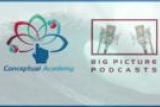Conceptual Chemistry
Chapter 17: Capturing Energy
Welcome to another episode of the Big Picture Podcast. For this “Back Story” segment for our nuclear chapter, we visit the site of the former Rocky Flats plutonium facility where from 1952 to 1989 plutonium triggers were produced for the hydrogen bombs in the USA nuclear arsenal. Major anti-nuclear protests were held at this site in the 1980s leading, in part, to its closure. Through decades of operation, much plutonium and other toxic chemicals were released into the local area, which is now a dedicated wild life refuge. We provide some of the history of Rocky Flats and even dig into some of the science behind the building of nuclear bombs. However, given the magnitude of significance, we also aim to provide space for reflection as supported by the audio nuances captured by our field recorder. Duration: 27:15.
[Coordinates: 39.883312, -105.235203]
Download: https://traffic.libsyn.com/secure/bigpicture/RockyFlatsMix4.mp3
Watch these additional videos to complete this tutorial.
Table of Videos
- Chapter 1: About Science
- Chapter 2: Particles of Matter
- Chapter 3: Elements of Chemistry
-
Chapter 4: Subatomic Particles
- 4.1 Physical and Conceptual Models
- 4.2 Discovering the Electron
- 4.3 Discovering the Atomic Nucleus
- 4.4 Protons and Neutrons
- 4.5 Light Is a Form of Energy
- 4.6 Atomic Spectra and the Quantum Hypothesis
- 4.7 Electrons Exhibit Wave Properties
- 4.8 Orbitals and Energy-Level Diagrams
- 4.9 The Shell Model and Periodic Table (Plus Chapter Review)
-
Chapter 5: The Atomic Nucleus
- 5.1 Unstable Nuclei
- 5.2 Radioactivity Is Natural
- 5.3 An Imbalance of Forces
- 5.4 Transmutation
- 5.5 Radioactive Half-Life
- 5.6 Isotopic Dating
- 5.7 Nuclear Fission
- 5.8 Mass and Energy
- 5.9 Nuclear Fusion (Plus Chapter Review)
-
Chapter 6: How Atoms Bond
- 6.1 Electron-Dot Structures
- 6.2 Ion Formation
- 6.3 Ionic Bonds
- 6.4 Metallic Bonds
- 6.5 Covalent Bonds
- 6.6 Molecular Shape
- 6.7 Polar Covalent Bonds
- 6.8 Molecular Polarity (Plus Chapter Review)
-
Chapter 7: How Molecules Mix
- 7.1 Dipole Attractions
- 7.2 Solutions
- 7.3 Concentration and the Mole
- 7.4 Solubility
- 7.5 How Soap Works
- 7.6 Softening Hard Water
- 7.7 Purifying Drinking Water (Plus Chapter Review)
-
Chapter 8: How Water Behaves
- 8.1 Open Structured Crystals
- 8.2 Melting and Freezing
- 8.3 The Stickiness of Water
- 8.4 Liquid and Gaseous Phases
- 8.5 Water's Specific Heat
- 8.6 Phase Changes and Energy (Plus Chapter Review)
-
Chapter 9: How Chemicals React
- 9.1 Chemical Equations
- 9.2 Measuring Molecules
- 9.3 Grams and Moles
- 9.4 Exothermic or Endothermic
- 9.5 Entropy and Chemical Reactions
- 9.6 Chemical Kinetics
- 9.7 Chemical Catalysts (Plus Review)
- 9.8 Chemical Equilibrium
-
Chapter 10: Acids and Bases
- 10.1 Exchanging Protons
- 10.2 Acid and Base Strength
- 10.3 Acidic, Basic, or Neutral
- 10.4 Buffers Resist pH Changes
- 10.5 Rainwater Is Acidic
- Ocean Acidification (Plus Chapter Review)
-
Chapter 11: Oxidations and Reductions
- 11.1 Losing and Gaining Electrons
- 11.2 Harnessing the Energy
- 11.3 Electricity from Batteries
- 11.4 Electricity from Fuel Cells
- 11.5 Energy from Photovoltaics
- 11.6 Electrolysis Produces Change
- 11.7 Producing Metals
- 11.8 Corrosion and Combustion (Plus Chapter Review)
-
Chapter 12: Organic Compounds
- 12.1 Hydrocarbons
- 12.2 Unsaturated Hydrocarbons
- 12.3 Functional Groups
- 12.4 Alcohols, Phenols, and Ethers
- 12.5 Amines and Alkaloids
- 12.6 Carbonyl Compounds
- 12.7 Organic Synthesis
- 12.8 Polymer Chemistry
- 12.9 History of Plastics (Plus Chapter Review)
-
Chapter 13: Nutrients of Life
- 13.1 Biomolecules
- 13.2 Carbohydrates
- 13.3 Lipids
- 13.4 Proteins
- 13.5 Nucleic Acids
- 13.6 Vitamins and Minerals
- 13.7 Metabolism
- 13.8 A Healthy Diet (Plus Chapter Review)
-
Chapter 14: Medicinal Chemistry
- 14.1 Medicines Improve Health
- 14.2 The Lock-and-Key Model
- 14.3 Chemotherapy
- 14.4 The Nervous System
- 14.5 Psychoactive Drugs
- 14.6 Pain Relievers
- 14.7 Medicines for the Heart (Plus Chapter Review)
-
Chapter 15: Optimizing Food Production
- 15.1 Humans Eat at All Trophic Levels
- 15.2 Plants Require Nutrients
- 15.3 Soil Fertility
- 15.4 Natural and Synthetic Fertilizers
- 15.5 Pesticides Kill Pests
- 15.6 Past Agricultural Practices
- 15.7 Quality Agricultural Practices (Plus Chapter Review)
-
Chapter 16: Water and Air Resources
- 16.1 Water on the Move
- 16.2 The Water We Consume
- 16.3 How We Pollute Water
- 16.4 Wastewater Treatment
- 16.5 The Earth’s Atmosphere
- 16.6 How We Pollute Air
- 16.7 Global Warming (Plus Chapter Review)
-
Chapter 17: Capturing Energy
- 17.1 Energy through Electricity
- 17.2 Fossil Fuels
- 17.3 The Nuclear Industry
- 17.4 Sustainable Energy Sources
- 17.5 Hydroelectricity
- 17.6 Biomass Is Chemical Energy
- 17.7 Direct Solar Energy
- 17.8 Solar Fuels (Plus Chapter Review)
- Review



